instrument panel SKODA ROOMSTER 2011 1.G Owner's Manual
[x] Cancel search | Manufacturer: SKODA, Model Year: 2011, Model line: ROOMSTER, Model: SKODA ROOMSTER 2011 1.GPages: 212, PDF Size: 3.3 MB
Page 11 of 212

Using the system
Cockpit General view This overview will help you to quickly familiarise yourself with the
displays and the control elements.
Power windows . . . . . . . . . . . . . . . . . . . . . . . . . . . . . . . . . . . . . . . . . . . . . . . . . . . . . . . . . 36
Electric exterior mirror adjustment . . . . . . . . . . . . . . . . . . . . . . . . . . . . . . . . . . . . 48
Air outlet vents . . . . . . . . . . . . . . . . . . . . . . . . . . . . . . . . . . . . . . . . . . . . . . . . . . . . . . . . . 70
Lever for the multi-functional switch:
– Turn signal light, headlight and parking light, headlight flasher . .43
– Speed regulating system . . . . . . . . . . . . . . . . . . . . . . . . . . . . . . . . . . . . . . . . . . . . 83
Steering wheel:
– with horn
– with driver airbag . . . . . . . . . . . . . . . . . . . . . . . . . . . . . . . . . . . . . . . . . . . . . . . . . . . . 111
– with controls for radio, radio navigation system and phone . . . . . .93
Instrument cluster: Instruments and indicator lights . . . . . . . . . . . . . . . . .10
Lever for the multi-functional switch:
– Multi-functional indicator . . . . . . . . . . . . . . . . . . . . . . . . . . . . . . . . . . . . . . . . . . . 14
– Windshield wiper and wash system . . . . . . . . . . . . . . . . . . . . . . . . . . . . . . . . 46
Switch for rear window heater . . . . . . . . . . . . . . . . . . . . . . . . . . . . . . . . . . . . . . . . . 45
TCS switch . . . . . . . . . . . . . . . . . . . . . . . . . . . . . . . . . . . . . . . . . . . . . . . . . . . . . . . . . . . . . . 125
Air outlet vents . . . . . . . . . . . . . . . . . . . . . . . . . . . . . . . . . . . . . . . . . . . . . . . . . . . . . . . . . 70
Switch for hazard warning lights . . . . . . . . . . . . . . . . . . . . . . . . . . . . . . . . . . . . . . 42
Indicator light for a switched off front seat passenger airbag . . . . . . .117
Depending on equipment fitted:
– Operating controls for the heating . . . . . . . . . . . . . . . . . . . . . . . . . . . . . . . . .
70
– Operating controls for the air conditioning system . . . . . . . . . . . . . . . .
72
– Operating controls for Climatronic . . . . . . . . . . . . . . . . . . . . . . . . . . . . . . . . . . 75
Storage compartments on the front passenger side . . . . . . . . . . . . . . . . .65
Front passenger airbag . . . . . . . . . . . . . . . . . . . . . . . . . . . . . . . . . . . . . . . . . . . . . . . . . 111
Switch passenger airbag deactivation . . . . . . . . . . . . . . . . . . . . . . . . . . . . . . . . . 117
1 2
3
4
5
6
7
8
9
10
11
12
13
14
15
16 Switch depending on equipment fitted:
–
Release for luggage compartment door . . . . . . . . . . . . . . . . . . . . . . . . . . . .33
– Interior monitor . . . . . . . . . . . . . . . . . . . . . . . . . . . . . . . . . . . . . . . . . . . . . . . . . . . . . . 36
Fuse box in the dash panel . . . . . . . . . . . . . . . . . . . . . . . . . . . . . . . . . . . . . . . . . . . . . 179
Light switch and headlamp beam adjustment . . . . . . . . . . . . . . . . . . . . . . . .39, 42
Release lever engine compartment lid . . . . . . . . . . . . . . . . . . . . . . . . . . . . . . . .150
Lever for adjusting the steering wheel . . . . . . . . . . . . . . . . . . . . . . . . . . . . . . . .78
Ignition lock . . . . . . . . . . . . . . . . . . . . . . . . . . . . . . . . . . . . . . . . . . . . . . . . . . . . . . . . . . . . . 78
Depending on equipment fitted:
– Radio
– Radio navigation system
Rocker switch for the heating on the driver's seat . . . . . . . . . . . . . . . . . . .51
Central locking switch . . . . . . . . . . . . . . . . . . . . . . . . . . . . . . . . . . . . . . . . . . . . . . . . . . 32
Depending on equipment fitted:
– Gearshift lever (manual gearbox) . . . . . . . . . . . . . . . . . . . . . . . . . . . . . . . . . . . 81
– Selector lever (automatic gearbox) . . . . . . . . . . . . . . . . . . . . . . . . . . . . . . . . . 89
Rocker switch for the heating on the driver's seat . . . . . . . . . . . . . . . . . . .51
Depending on equipment fitted:
– Ashtrays . . . . . . . . . . . . . . . . . . . . . . . . . . . . . . . . . . . . . . . . . . . . . . . . . . . . . . . . . . . . . . 63
– Storage compartment . . . . . . . . . . . . . . . . . . . . . . . . . . . . . . . . . . . . . . . . . . . . . . . 66
MDI . . . . . . . . . . . . . . . . . . . . . . . . . . . . . . . . . . . . . . . . . . . . . . . . . . . . . . . . . . . . . . . . . . . . . . 100 Note
● Cars with factory-fitted radio or navigation system are supplied with separate
instructions for operating such equipment.
● The arrangement of the controls and switches and the location of some items
on right-hand drive models may differ from that shown in ⇒
fig. 1. The symbols on
the controls and switches are the same as for left-hand drive models. 17
18
19
20
21
22
23
24
25
26
27
28
29 9
Cockpit Using the system Safety Driving Tips General Maintenance Breakdown assis-
tance Praktik Technical data
Page 15 of 212
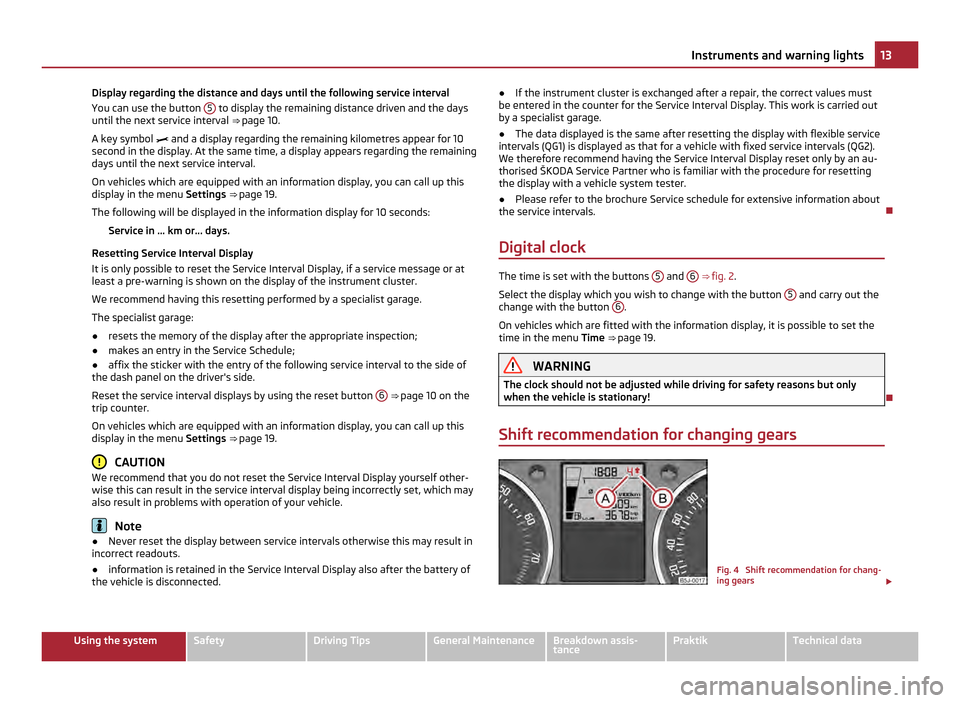
Display regarding the distance and days until the following service interval
You can use the button
5 to display the remaining distance driven and the days
until the next service interval ⇒
page 10.
A key symbol and a display regarding the remaining kilometres appear for 10
second in the display. At the same time, a display appears regarding the remaining
days until the next service interval.
On vehicles which are equipped with an information display, you can call up this
display in the menu Settings ⇒ page 19.
The following will be displayed in the information display for 10 seconds: Service in ... km or... days.
Resetting Service Interval Display
It is only possible to reset the Service Interval Display, if a service message or at
least a pre-warning is shown on the display of the instrument cluster.
We recommend having this resetting performed by a specialist garage.
The specialist garage:
● resets the memory of the display after the appropriate inspection;
● makes an entry in the Service Schedule;
● affix the sticker with the entry of the following service interval to the side of
the dash panel on the driver's side.
Reset the service interval displays by using the reset button 6
⇒ page 10 on the
trip counter.
On vehicles which are equipped with an information display, you can call up this
display in the menu Settings ⇒ page 19
. CAUTION
We recommend that you do not reset the Service Interval Display yourself other-
wise this can result in the service interval display being incorrectly set, which may
also result in problems with operation of your vehicle. Note
● Never reset the display between service intervals otherwise this may result in
incorrect readouts.
● information is retained in the Service Interval Display also after the battery of
the vehicle is disconnected. ●
If the instrument cluster is exchanged after a repair, the correct values must
be entered in the counter for the Service Interval Display. This work is carried out
by a specialist garage.
● The data displayed is the same after resetting the display with flexible service
intervals (QG1) is displayed as that for a vehicle with fixed service intervals (QG2).
We therefore recommend having the Service Interval Display reset only by an au-
thorised
ŠKODA Service Partner who is familiar with the procedure for resetting
the display with a vehicle system tester.
● Please refer to the brochure Service schedule for extensive information about
the service intervals.
Digital clock The time is set with the buttons
5 and
6
⇒
fig. 2.
Select the display which you wish to change with the button 5 and carry out the
change with the button 6 .
On vehicles which are fitted with the information display, it is possible to set the
time in the menu Time ⇒
page 19. WARNING
The clock should not be adjusted while driving for safety reasons but only
when the vehicle is stationary!
Shift recommendation for changing gears Fig. 4 Shift recommendation for chang-
ing gears
£ 13
Instruments and warning lights Using the system Safety Driving Tips General Maintenance Breakdown assis-
tance Praktik Technical data
Page 29 of 212
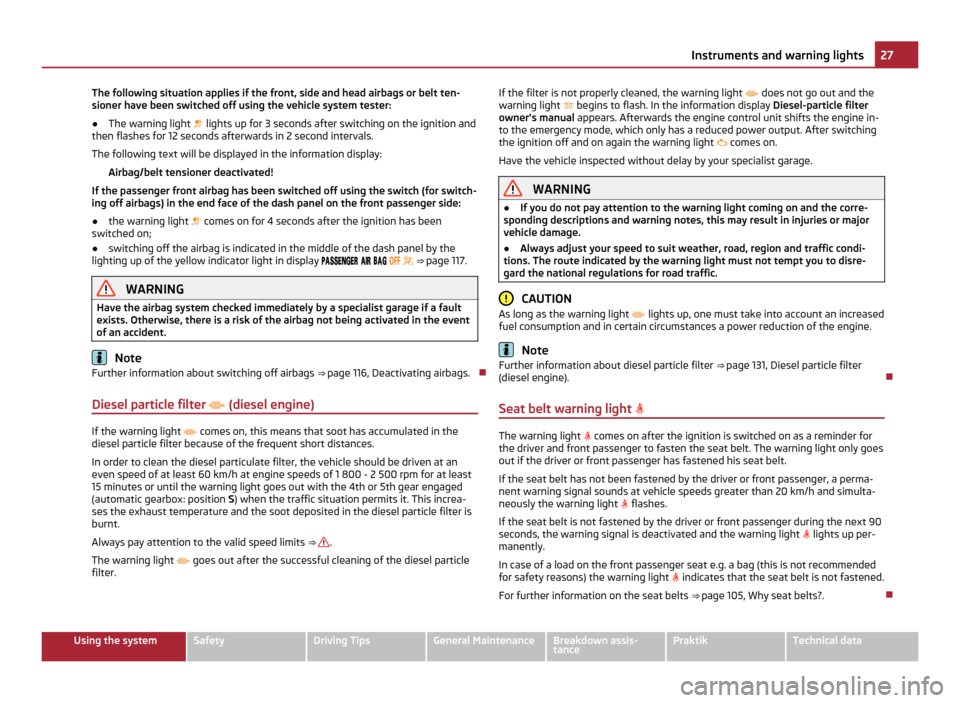
The following situation applies if the front, side and head airbags or belt ten-
sioner have been switched off using the vehicle system tester:
●
The warning light lights up for 3 seconds after switching on the ignition and
then flashes for 12 seconds afterwards in 2 second intervals.
The following text will be displayed in the information display: Airbag/belt tensioner deactivated!
If the passenger front airbag has been switched off using the switch (for switch-
ing off airbags) in the end face of the dash panel on the front passenger side:
● the warning light comes on for 4 seconds after the ignition has been
switched on;
● switching off the airbag is indicated in the middle of the dash panel by the
lighting up of the yellow indicator light in display
⇒ page 117. WARNING
Have the airbag system checked immediately by a specialist garage if a fault
exists. Otherwise, there is a risk of the airbag not being activated in the event
of an accident. Note
Further information about switching off airbags ⇒ page 116
, Deactivating airbags.
Diesel particle filter (diesel engine) If the warning light
comes on, this means that soot has accumulated in the
diesel particle filter because of the frequent short distances.
In order to clean the diesel particulate filter, the vehicle should be driven at an
even speed of at least 60 km/h at engine speeds of 1
800 - 2 500 rpm for at least
15 minutes or until the warning light goes out with the 4th or 5th gear engaged
(automatic gearbox: position S) when the traffic situation permits it. This increa-
ses the exhaust temperature and the soot deposited in the diesel particle filter is
burnt.
Always pay attention to the valid speed limits ⇒ .
The warning light
goes out after the successful cleaning of the diesel particle
filter. If the filter is not properly cleaned, the warning light
does not go out and the
warning light begins to flash. In the information display Diesel-particle filter
owner's manual appears. Afterwards the engine control unit shifts the engine in-
to the emergency mode, which only has a reduced power output. After switching
the ignition off and on again the warning light comes on.
Have the vehicle inspected without delay by your specialist garage. WARNING
● If you do not pay attention to the warning light coming on and the corre-
sponding descriptions and warning notes, this may result in injuries or major
vehicle damage.
● Always adjust your speed to suit weather, road, region and traffic condi-
tions. The route indicated by the warning light must not tempt you to disre-
gard the national regulations for road traffic. CAUTION
As long as the warning light lights up, one must take into account an increased
fuel consumption and in certain circumstances a power reduction of the engine. Note
Further information about diesel particle filter ⇒
page 131, Diesel particle filter
(diesel engine).
Seat belt warning light The warning light
comes on after the ignition is switched on as a reminder for
the driver and front passenger to fasten the seat belt. The warning light only goes
out if the driver or front passenger has fastened his seat belt.
If the seat belt has not been fastened by the driver or front passenger, a perma-
nent warning signal sounds at vehicle speeds greater than 20 km/h and simulta-
neously the warning light flashes.
If the seat belt is not fastened by the driver or front passenger during the next 90
seconds, the warning signal is deactivated and the warning light lights up per-
manently.
In case of a load on the front passenger seat e.g. a bag (this is not recommended
for safety reasons) the warning light indicates that the seat belt is not fastened.
For further information on the seat belts ⇒ page 105, Why seat belts?
. 27
Instruments and warning lights Using the system Safety Driving Tips General Maintenance Breakdown assis-
tance Praktik Technical data
Page 42 of 212
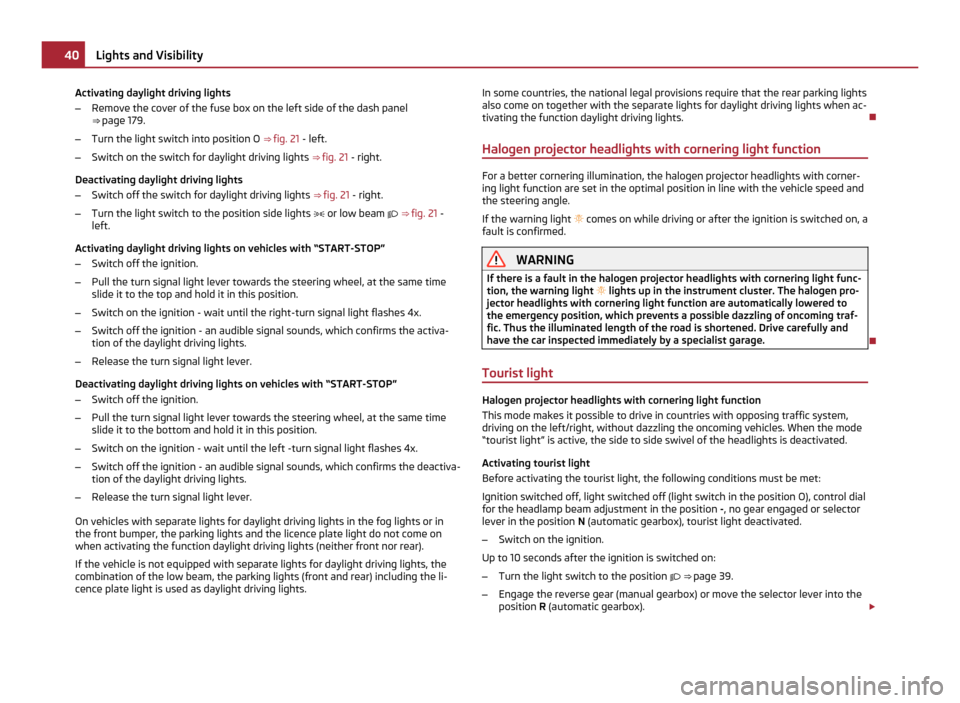
Activating daylight driving lights
–
Remove the cover of the fuse box on the left side of the dash panel
⇒ page 179.
– Turn the light switch into position O ⇒ fig. 21 - left.
– Switch on the switch for daylight driving lights ⇒ fig. 21 - right.
Deactivating daylight driving lights
– Switch off the switch for daylight driving lights ⇒ fig. 21 - right.
– Turn the light switch to the position side lights or low beam ⇒
fig. 21 -
left.
Activating daylight driving lights on vehicles with “START-STOP”
– Switch off the ignition.
– Pull the turn signal light lever towards the steering wheel, at the same time
slide it to the top and hold it in this position.
– Switch on the ignition - wait until the right-turn signal light flashes 4x.
– Switch off the ignition - an audible signal sounds, which confirms the activa-
tion of the daylight driving lights.
– Release the turn signal light lever.
Deactivating daylight driving lights on vehicles with
“START-STOP”
– Switch off the ignition.
– Pull the turn signal light lever towards the steering wheel, at the same time
slide it to the bottom and hold it in this position.
– Switch on the ignition - wait until the left -turn signal light flashes 4x.
– Switch off the ignition - an audible signal sounds, which confirms the deactiva-
tion of the daylight driving lights.
– Release the turn signal light lever.
On vehicles with separate lights for daylight driving lights in the fog lights or in
the front bumper, the parking lights and the licence plate light do not come on
when activating the function daylight driving lights (neither front nor rear).
If the vehicle is not equipped with separate lights for daylight driving lights, the
combination of the low beam, the parking lights (front and rear) including the li-
cence plate light is used as daylight driving lights. In some countries, the national legal provisions require that the rear parking lights
also come on together with the separate lights for daylight driving lights when ac-
tivating the function daylight driving lights.
Halogen projector headlights with cornering light function For a better cornering illumination, the halogen projector headlights with corner-
ing light function are set in the optimal position in line with the vehicle speed and
the steering angle.
If the warning light
comes on while driving or after the ignition is switched on, a
fault is confirmed. WARNING
If there is a fault in the halogen projector headlights with cornering light func-
tion, the warning light lights up in the instrument cluster. The halogen pro-
jector headlights with cornering light function are automatically lowered to
the emergency position, which prevents a possible dazzling of oncoming traf-
fic. Thus the illuminated length of the road is shortened. Drive carefully and
have the car inspected immediately by a specialist garage.
Tourist light Halogen projector headlights with cornering light function
This mode makes it possible to drive in countries with opposing traffic system,
driving on the left/right, without dazzling the oncoming vehicles. When the mode
“tourist light
” is active, the side to side swivel of the headlights is deactivated.
Activating tourist light
Before activating the tourist light, the following conditions must be met:
Ignition switched off, light switched off (light switch in the position O), control dial
for the headlamp beam adjustment in the position -, no gear engaged or selector
lever in the position N (automatic gearbox), tourist light deactivated.
– Switch on the ignition.
Up to 10 seconds after the ignition is switched on:
– Turn the light switch to the position ⇒ page 39.
– Engage the reverse gear (manual gearbox) or move the selector lever into the
position R
(automatic gearbox). £40
Lights and Visibility
Page 43 of 212
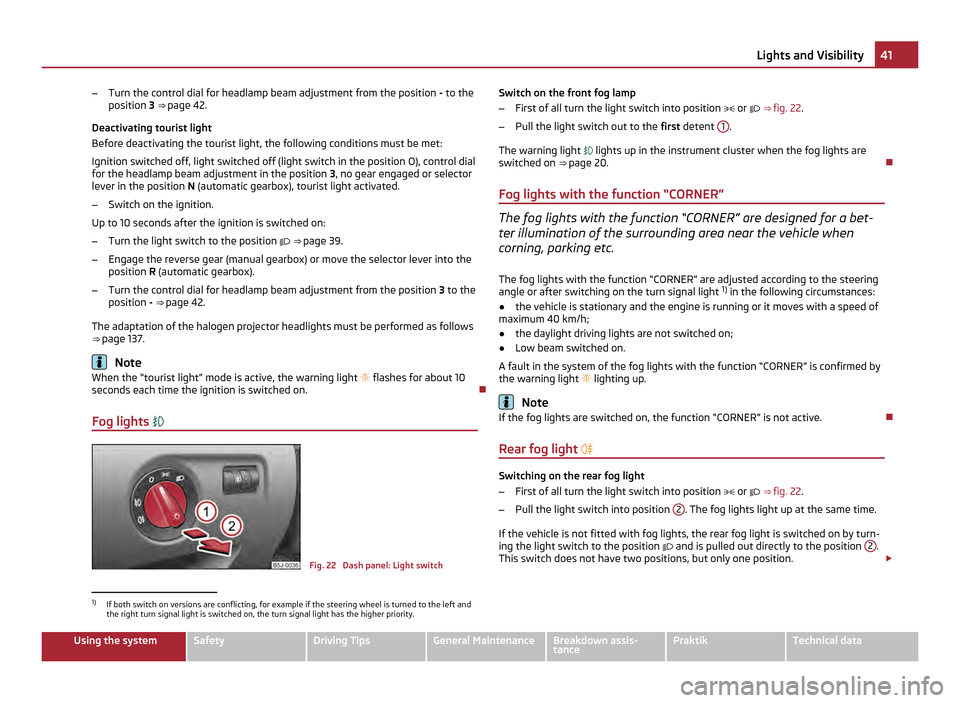
–
Turn the control dial for headlamp beam adjustment from the position - to the
position 3 ⇒ page 42.
Deactivating tourist light
Before deactivating the tourist light, the following conditions must be met:
Ignition switched off, light switched off (light switch in the position O), control dial
for the headlamp beam adjustment in the position 3, no gear engaged or selector
lever in the position N (automatic gearbox), tourist light activated.
– Switch on the ignition.
Up to 10 seconds after the ignition is switched on:
– Turn the light switch to the position ⇒ page 39.
– Engage the reverse gear (manual gearbox) or move the selector lever into the
position R
(automatic gearbox).
– Turn the control dial for headlamp beam adjustment from the position 3 to the
position - ⇒ page 42.
The adaptation of the halogen projector headlights must be performed as follows
⇒ page 137
. Note
When the “tourist light” mode is active, the warning light flashes for about 10
seconds each time the ignition is switched on.
Fog lights Fig. 22 Dash panel: Light switchSwitch on the front fog lamp
–
First of all turn the light switch into position or ⇒
fig. 22.
– Pull the light switch out to the first detent 1 .
The warning light lights up in the instrument cluster when the fog lights are
switched on ⇒
page 20.
Fog lights with the function “CORNER” The fog lights with the function “CORNER” are designed for a bet-
ter illumination of the surrounding area near the vehicle when
corning, parking etc.
The fog lights with the function
“CORNER” are adjusted according to the steering
angle or after switching on the turn signal light 1)
in the following circumstances:
● the vehicle is stationary and the engine is running or it moves with a speed of
maximum 40 km/h;
● the daylight driving lights are not switched on;
● Low beam switched on.
A fault in the system of the fog lights with the function
“CORNER” is confirmed by
the warning light lighting up. Note
If the fog lights are switched on, the function “CORNER” is not active.
Rear fog light Switching on the rear fog light
–
First of all turn the light switch into position or ⇒
fig. 22.
– Pull the light switch into position 2 . The fog lights light up at the same time.
If the vehicle is not fitted with fog lights, the rear fog light is switched on by turn-
ing the light switch to the position and is pulled out directly to the position 2 .
This switch does not have two positions, but only one position. £1)
If both switch on versions are conflicting, for example if the steering wheel is turned to the left and
the right turn signal light is switched on, the turn signal light has the higher priority. 41
Lights and Visibility Using the system Safety Driving Tips General Maintenance Breakdown assis-
tance Praktik Technical data
Page 44 of 212
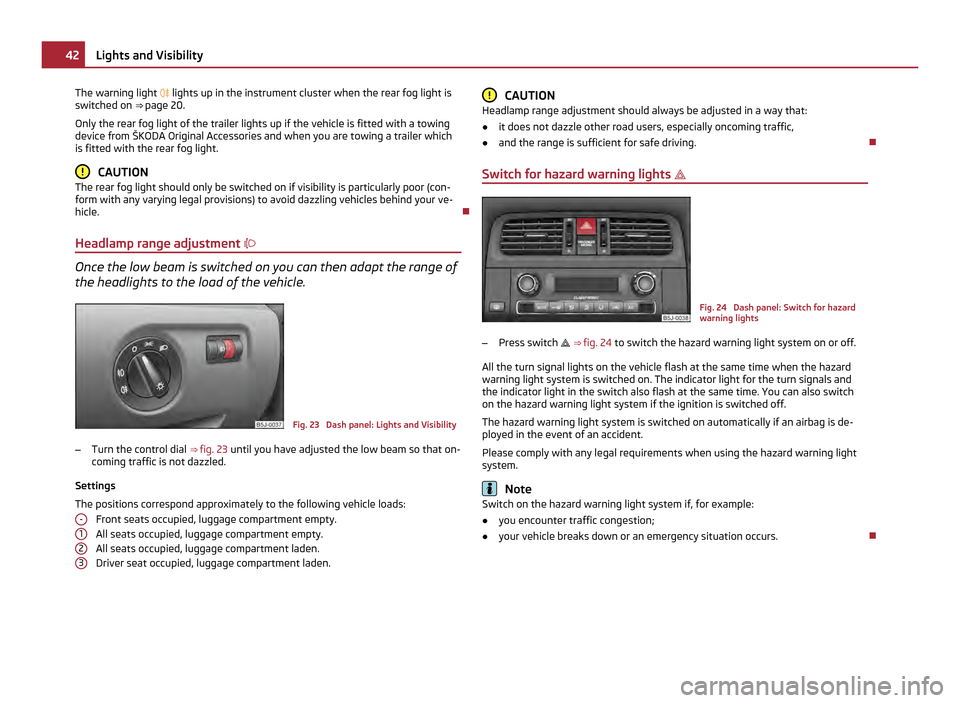
The warning light
lights up in the instrument cluster when the rear fog light is
switched on ⇒ page 20.
Only the rear fog light of the trailer lights up if the vehicle is fitted with a towing
device from ŠKODA Original Accessories and when you are towing a trailer which
is fitted with the rear fog light. CAUTION
The rear fog light should only be switched on if visibility is particularly poor (con-
form with any varying legal provisions) to avoid dazzling vehicles behind your ve-
hicle.
Headlamp range adjustment Once the low beam is switched on you can then adapt the range of
the headlights to the load of the vehicle.
Fig. 23 Dash panel: Lights and Visibility
– Turn the control dial ⇒
fig. 23 until you have adjusted the low beam so that on-
coming traffic is not dazzled.
Settings
The positions correspond approximately to the following vehicle loads: Front seats occupied, luggage compartment empty.
All seats occupied, luggage compartment empty.
All seats occupied, luggage compartment laden.
Driver seat occupied, luggage compartment laden.
- 1
2
3 CAUTION
Headlamp range adjustment should always be adjusted in a way that:
● it does not dazzle other road users, especially oncoming traffic,
● and the range is sufficient for safe driving.
Switch for hazard warning lights Fig. 24 Dash panel: Switch for hazard
warning lights
– Press switch ⇒ fig. 24 to switch the hazard warning light system on or off.
All the turn signal lights on the vehicle flash at the same time when the hazard
warning light system is switched on. The indicator light for the turn signals and
the indicator light in the switch also flash at the same time. You can also switch
on the hazard warning light system if the ignition is switched off.
The hazard warning light system is switched on automatically if an airbag is de-
ployed in the event of an accident.
Please comply with any legal requirements when using the hazard warning light
system. Note
Switch on the hazard warning light system if, for example:
● you encounter traffic congestion;
● your vehicle breaks down or an emergency situation occurs. 42
Lights and Visibility
Page 52 of 212
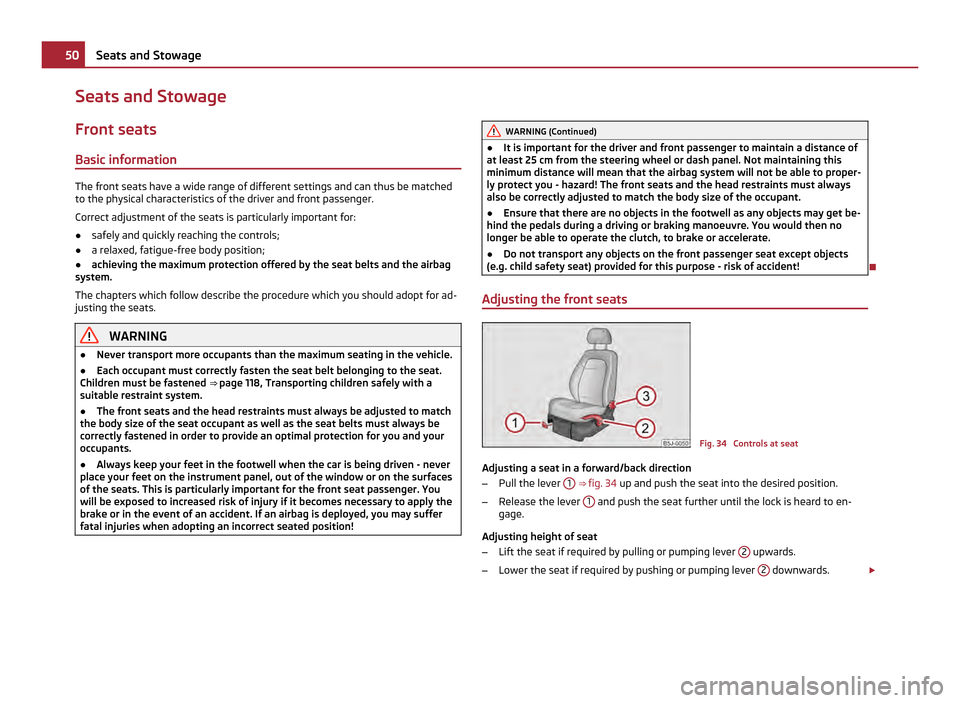
Seats and Stowage
Front seats
Basic information The front seats have a wide range of different settings and can thus be matched
to the physical characteristics of the driver and front passenger.
Correct adjustment of the seats is particularly important for:
● safely and quickly reaching the controls;
● a relaxed, fatigue-free body position;
● achieving the maximum protection offered by the seat belts and the airbag
system.
The chapters which follow describe the procedure which you should adopt for ad-
justing the seats. WARNING
● Never transport more occupants than the maximum seating in the vehicle.
● Each occupant must correctly fasten the seat belt belonging to the seat.
Children must be fastened ⇒
page 118, Transporting children safely with a
suitable restraint system.
● The front seats and the head restraints must always be adjusted to match
the body size of the seat occupant as well as the seat belts must always be
correctly fastened in order to provide an optimal protection for you and your
occupants.
● Always keep your feet in the footwell when the car is being driven - never
place your feet on the instrument panel, out of the window or on the surfaces
of the seats. This is particularly important for the front seat passenger. You
will be exposed to increased risk of injury if it becomes necessary to apply the
brake or in the event of an accident. If an airbag is deployed, you may suffer
fatal injuries when adopting an incorrect seated position! WARNING (Continued)
● It is important for the driver and front passenger to maintain a distance of
at least 25 cm from the steering wheel or dash panel. Not maintaining this
minimum distance will mean that the airbag system will not be able to proper-
ly protect you - hazard! The front seats and the head restraints must always
also be correctly adjusted to match the body size of the occupant.
● Ensure that there are no objects in the footwell as any objects may get be-
hind the pedals during a driving or braking manoeuvre. You would then no
longer be able to operate the clutch, to brake or accelerate.
● Do not transport any objects on the front passenger seat except objects
(e.g. child safety seat) provided for this purpose - risk of accident!
Adjusting the front seats Fig. 34 Controls at seat
Adjusting a seat in a forward/back direction
– Pull the lever 1
⇒
fig. 34 up and push the seat into the desired position.
– Release the lever 1 and push the seat further until the lock is heard to en-
gage.
Adjusting height of seat
– Lift the seat if required by pulling or pumping lever 2 upwards.
– Lower the seat if required by pushing or pumping lever 2 downwards.
£50
Seats and Stowage
Page 105 of 212
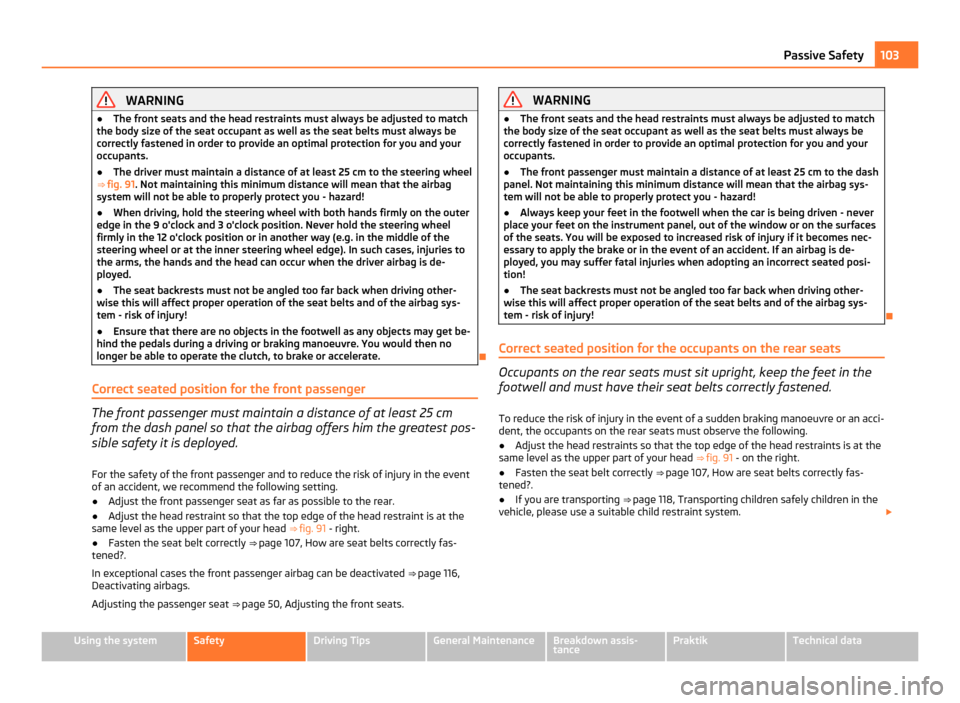
WARNING
● The front seats and the head restraints must always be adjusted to match
the body size of the seat occupant as well as the seat belts must always be
correctly fastened in order to provide an optimal protection for you and your
occupants.
● The driver must maintain a distance of at least 25 cm to the steering wheel
⇒ fig. 91. Not maintaining this minimum distance will mean that the airbag
system will not be able to properly protect you - hazard!
● When driving, hold the steering wheel with both hands firmly on the outer
edge in the 9 o'clock and 3 o'clock position. Never hold the steering wheel
firmly in the 12 o'clock position or in another way (e.g. in the middle of the
steering wheel or at the inner steering wheel edge). In such cases, injuries to
the arms, the hands and the head can occur when the driver airbag is de-
ployed.
● The seat backrests must not be angled too far back when driving other-
wise this will affect proper operation of the seat belts and of the airbag sys-
tem - risk of injury!
● Ensure that there are no objects in the footwell as any objects may get be-
hind the pedals during a driving or braking manoeuvre. You would then no
longer be able to operate the clutch, to brake or accelerate.
Correct seated position for the front passenger The front passenger must maintain a distance of at least 25 cm
from the dash panel so that the airbag offers him the greatest pos-
sible safety it is deployed.
For the safety of the front passenger and to reduce the risk of injury in the event
of an accident, we recommend the following setting.
● Adjust the front passenger seat as far as possible to the rear.
● Adjust the head restraint so that the top edge of the head restraint is at the
same level as the upper part of your head ⇒
fig. 91 - right.
● Fasten the seat belt correctly ⇒
page 107, How are seat belts correctly fas-
tened?.
In exceptional cases the front passenger airbag can be deactivated ⇒ page 116,
Deactivating airbags.
Adjusting the passenger seat ⇒ page 50, Adjusting the front seats. WARNING
● The front seats and the head restraints must always be adjusted to match
the body size of the seat occupant as well as the seat belts must always be
correctly fastened in order to provide an optimal protection for you and your
occupants.
● The front passenger must maintain a distance of at least 25 cm to the dash
panel. Not maintaining this minimum distance will mean that the airbag sys-
tem will not be able to properly protect you - hazard!
● Always keep your feet in the footwell when the car is being driven - never
place your feet on the instrument panel, out of the window or on the surfaces
of the seats. You will be exposed to increased risk of injury if it becomes nec-
essary to apply the brake or in the event of an accident. If an airbag is de-
ployed, you may suffer fatal injuries when adopting an incorrect seated posi-
tion!
● The seat backrests must not be angled too far back when driving other-
wise this will affect proper operation of the seat belts and of the airbag sys-
tem - risk of injury!
Correct seated position for the occupants on the rear seats Occupants on the rear seats must sit upright, keep the feet in the
footwell and must have their seat belts correctly fastened.
To reduce the risk of injury in the event of a sudden braking manoeuvre or an acci-
dent, the occupants on the rear seats must observe the following.
● Adjust the head restraints so that the top edge of the head restraints is at the
same level as the upper part of your head ⇒ fig. 91
- on the right.
● Fasten the seat belt correctly
⇒ page 107, How are seat belts correctly fas-
tened?.
● If you are transporting
⇒ page 118
, Transporting children safely children in the
vehicle, please use a suitable child restraint system. £ 103
Passive Safety Using the system Safety Driving Tips General Maintenance Breakdown assis-
tance Praktik Technical data
Page 112 of 212
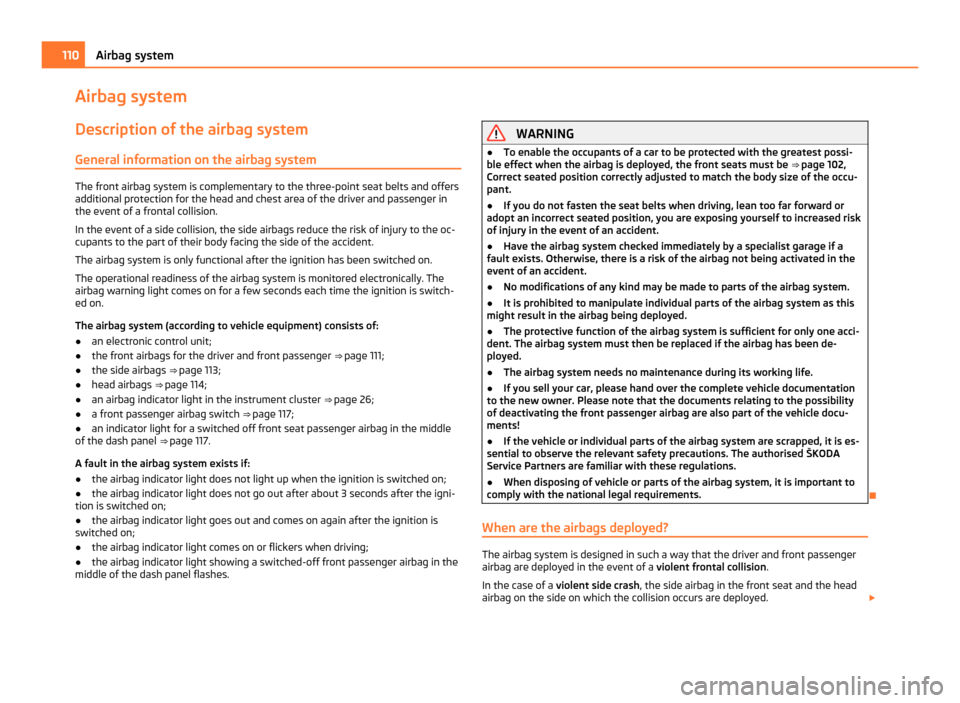
Airbag system
Description of the airbag system General information on the airbag system The front airbag system is complementary to the three-point seat belts and offers
additional protection for the head and chest area of the driver and passenger in
the event of a frontal collision.
In the event of a side collision, the side airbags reduce the risk of injury to the oc-
cupants to the part of their body facing the side of the accident.
The airbag system is only functional after the ignition has been switched on.
The operational readiness of the airbag system is monitored electronically. The
airbag warning light comes on for a few seconds each time the ignition is switch-
ed on.
The airbag system (according to vehicle equipment) consists of:
● an electronic control unit;
● the front airbags for the driver and front passenger ⇒ page 111;
● the side airbags ⇒ page 113;
● head airbags ⇒ page 114;
● an airbag indicator light in the instrument cluster ⇒ page 26;
● a front passenger airbag switch ⇒ page 117;
● an indicator light for a switched off front seat passenger airbag in the middle
of the dash panel ⇒
page 117.
A fault in the airbag system exists if:
● the airbag indicator light does not light up when the ignition is switched on;
● the airbag indicator light does not go out after about 3 seconds after the igni-
tion is switched on;
● the airbag indicator light goes out and comes on again after the ignition is
switched on;
● the airbag indicator light comes on or flickers when driving;
● the airbag indicator light showing a switched-off front passenger airbag in the
middle of the dash panel flashes. WARNING
● To enable the occupants of a car to be protected with the greatest possi-
ble effect when the airbag is deployed, the front seats must be ⇒
page 102,
Correct seated position correctly adjusted to match the body size of the occu-
pant.
● If you do not fasten the seat belts when driving, lean too far forward or
adopt an incorrect seated position, you are exposing yourself to increased risk
of injury in the event of an accident.
● Have the airbag system checked immediately by a specialist garage if a
fault exists. Otherwise, there is a risk of the airbag not being activated in the
event of an accident.
● No modifications of any kind may be made to parts of the airbag system.
● It is prohibited to manipulate individual parts of the airbag system as this
might result in the airbag being deployed.
● The protective function of the airbag system is sufficient for only one acci-
dent. The airbag system must then be replaced if the airbag has been de-
ployed.
● The airbag system needs no maintenance during its working life.
● If you sell your car, please hand over the complete vehicle documentation
to the new owner. Please note that the documents relating to the possibility
of deactivating the front passenger airbag are also part of the vehicle docu-
ments!
● If the vehicle or individual parts of the airbag system are scrapped, it is es-
sential to observe the relevant safety precautions. The authorised
ŠKODA
Service Partners are familiar with these regulations.
● When disposing of vehicle or parts of the airbag system, it is important to
comply with the national legal requirements.
When are the airbags deployed? The airbag system is designed in such a way that the driver and front passenger
airbag are deployed in the event of a violent frontal collision
.
In the case of a violent side crash , the side airbag in the front seat and the head
airbag on the side on which the collision occurs are deployed. £110
Airbag system
Page 118 of 212
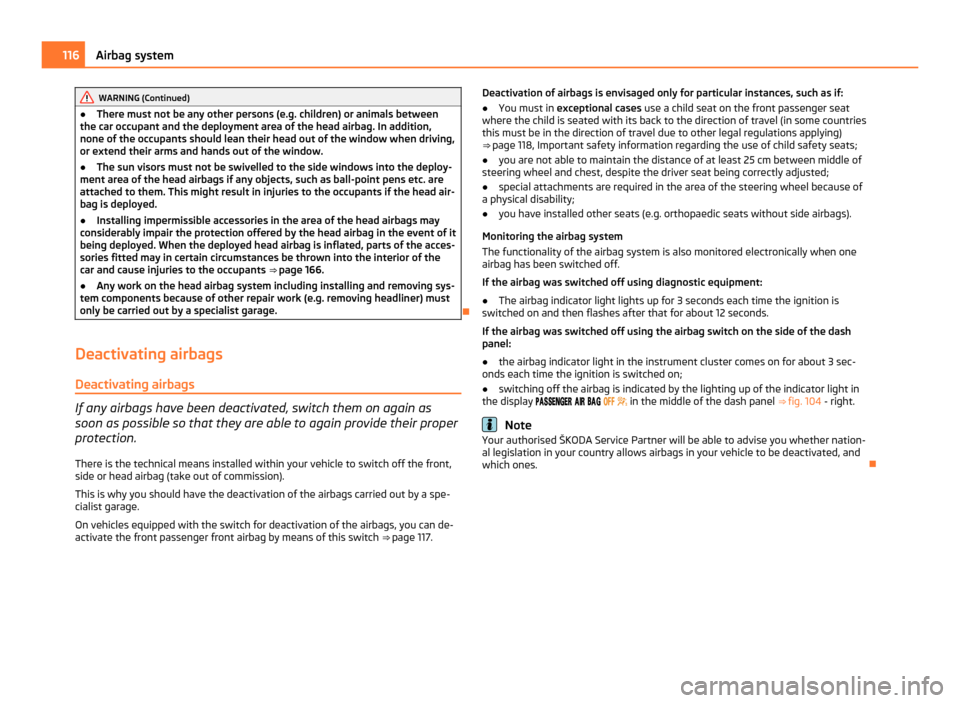
WARNING (Continued)
● There must not be any other persons (e.g. children) or animals between
the car occupant and the deployment area of the head airbag. In addition,
none of the occupants should lean their head out of the window when driving,
or extend their arms and hands out of the window.
● The sun visors must not be swivelled to the side windows into the deploy-
ment area of the head airbags if any objects, such as ball-point pens etc. are
attached to them. This might result in injuries to the occupants if the head air-
bag is deployed.
● Installing impermissible accessories in the area of the head airbags may
considerably impair the protection offered by the head airbag in the event of it
being deployed. When the deployed head airbag is inflated, parts of the acces-
sories fitted may in certain circumstances be thrown into the interior of the
car and cause injuries to the occupants ⇒
page 166.
● Any work on the head airbag system including installing and removing sys-
tem components because of other repair work (e.g. removing headliner) must
only be carried out by a specialist garage.
Deactivating airbags Deactivating airbags If any airbags have been deactivated, switch them on again as
soon as possible so that they are able to again provide their proper
protection.
There is the technical means installed within your vehicle to switch off the front,
side or head airbag (take out of commission).
This is why you should have the deactivation of the airbags carried out by a spe-
cialist garage.
On vehicles equipped with the switch for deactivation of the airbags, you can de-
activate the front passenger front airbag by means of this switch ⇒ page 117. Deactivation of airbags is envisaged only for particular instances, such as if:
●
You must in exceptional cases use a child seat on the front passenger seat
where the child is seated with its back to the direction of travel (in some countries
this must be in the direction of travel due to other legal regulations applying)
⇒ page 118, Important safety information regarding the use of child safety seats
;
● you are not able to maintain the distance of at least 25 cm between middle of
steering wheel and chest, despite the driver seat being correctly adjusted;
● special attachments are required in the area of the steering wheel because of
a physical disability;
● you have installed other seats (e.g. orthopaedic seats without side airbags).
Monitoring the airbag system
The functionality of the airbag system is also monitored electronically when one
airbag has been switched off.
If the airbag was switched off using diagnostic equipment:
● The airbag indicator light lights up for 3 seconds each time the ignition is
switched on and then flashes after that for about 12 seconds.
If the airbag was switched off using the airbag switch on the side of the dash
panel:
● the airbag indicator light in the instrument cluster comes on for about 3 sec-
onds each time the ignition is switched on;
● switching off the airbag is indicated by the lighting up of the indicator light in
the display
in the middle of the dash panel ⇒ fig. 104 - right. Note
Your authorised ŠKODA Service Partner will be able to advise you whether nation-
al legislation in your country allows airbags in your vehicle to be deactivated, and
which ones. 116
Airbag system